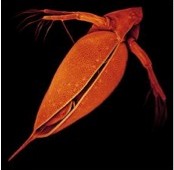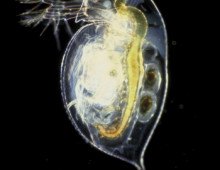A keystone species in freshwater ecosystems, the water flea Daphnia pulex, is roughly the size of the equal sign on a keyboard. In the February 4 issue of Science, the nearly decade-long collaboration between the Daphnia Genomics Consortium and the DOE JGI culminated with a report on this first crustacean genome. “Daphnia is one of…
Sentinel of Change: Water Flea Genome to Improve Environmental Monitoring Capabilities
WALNUT CREEK, Calif.—A tiny crustacean that has been used for decades to develop and monitor environmental regulations is the first of its kind to have its genetic code sequenced and analyzed—revealing the most gene-packed animal characterized to date. The information deciphered could help researchers develop and conduct real-time monitoring systems of the effects of environmental…
Cow rumen metagenome study in EarthSky
Enter: the cow. If cows are good at anything, it’s digesting plant material until it turns into sugar; Dr. Rubin noted that cows have been eating grass for a few million years. That’s why Rubin’s team decided to do major genetic analysis of microbes inside the stomachs of cows. He explained that he was interested…
Cow rumen metagenome study on BBC World Service: Science in Action
Growing crops to make bio-fuel is controversial – they can take up valuable land and resources that could be used for food production and in the case of oil palms, large tracts of rainforest have been cleared to make way for this cash crop. But the second generation of bio-fuels hope to make use of…
Rumenating on improving biofuel production
Developing alternative fuels from plants has been challenging in part due to the high costs associated with processing plant biomass to more easily convert it into sugars and from there into biofuels. Ruminants such as the cow, however, can eat more than a hundred pounds of plant matter a day and break it down. Switchgrass…
Cow rumen metagenome study on COSMOS Magazine
The result was 270 billion base pairs of genetic code, almost a hundred times more than the human genome, and an estimated two million potential genes to be investigated. To find which bacteria could digest cellulose, the researchers compared codes with known regions of Carbohydrate Active Enzymes called CAZymes. “Regions include domains that bind cellulose…
Cow rumen metagenome study in R&D Magazine
In the new study, the researchers focused on switchgrass, a promising biofuels crop. After incubating the switchgrass in the rumen for 72 hours, researchers conducted a genomic analysis of all of the microbes that adhered to switchgrass. This “metagenomic” approach, led by Edward Rubin, of the DOE Joint Genome Institute and the Lawrence Berkeley National…
Cow rumen metagenome study on Mother Nature Network
Ethanol makers will produce about 13 billion gallons of the renewable fuel this year, chiefly from corn. A 2007 law requires annual use of 36 billion gallons from 2022 and reserves 21 billion gallons of it for “advanced” biofuels. The U.S. government offered $1.5 billion in October to help bring next-generation biofuels to market….
Cow rumen metagenome study on Scicasts
“The problem with second-generation biofuels is the problem of unlocking the soluble fermentable sugars that are in the plant cell wall,” said University of Illinois animal sciences professor Roderick Mackie, an author on the study whose research into the microbial life of the bovine rumen set the stage for the new approach. “The cow’s been…
Cow rumen metagenome study on GenomeWeb’s The Daily Scan
In Science this week, a team led by investigators at the US Department of Energy Joint Genome Institute reports its discovery of 27,755 putative carbohydrate-active genes among cow rumen microbes through metagenomic sequencing. The team also found that these genes “expressed 90 candidate proteins, of which 57 percent were enzymatically active against cellulosic substrates,” which…

